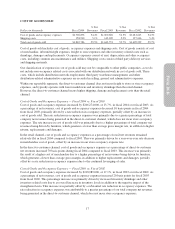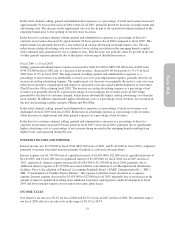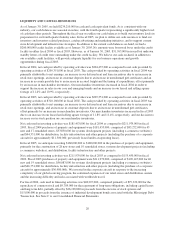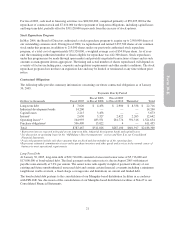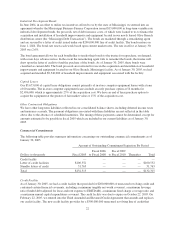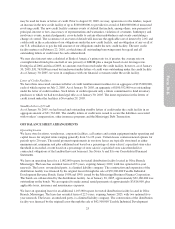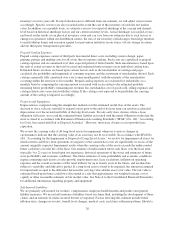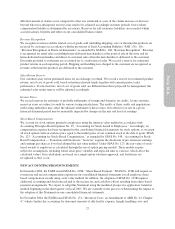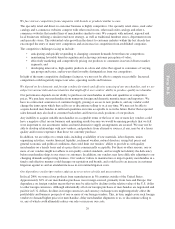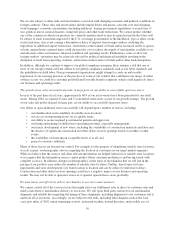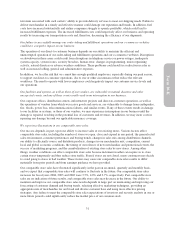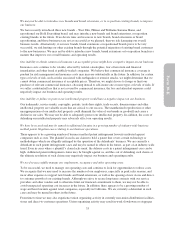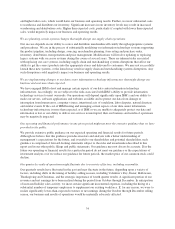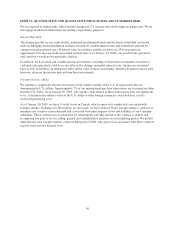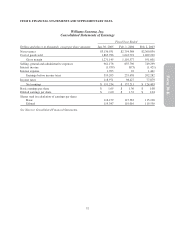Pottery Barn 2004 Annual Report Download - page 34
Download and view the complete annual report
Please find page 34 of the 2004 Pottery Barn annual report below. You can navigate through the pages in the report by either clicking on the pages listed below, or by using the keyword search tool below to find specific information within the annual report.
different amount of claims occur compared to what was estimated or costs of the claims increase or decrease
beyond what was anticipated, reserves may need to be adjusted accordingly in future periods. Our workers’
compensation liability is determined by an actuary. Reserves for self-insurance liabilities are recorded within
accrued salaries, benefits and other on our consolidated balance sheet.
Revenue Recognition
We recognize revenues and the related cost of goods sold (including shipping costs) at the time the products are
received by customers in accordance with the provisions of Staff Accounting Bulletin (“SAB”) No. 101,
“Revenue Recognition in Financial Statements” as amended by SAB No. 104, “Revenue Recognition.” Revenue
is recognized for retail sales (excluding home-delivered merchandise) at the point of sale in the store and for
home-delivered merchandise and direct-to-customer sales when the merchandise is delivered to the customer.
Discounts provided to customers are accounted for as a reduction of sales. We record a reserve for estimated
product returns in each reporting period. Shipping and handling fees charged to the customer are recognized as
revenue at the time the products are delivered to the customer.
Sales Return Reserve
Our customers may return purchased items for an exchange or refund. We record a reserve for estimated product
returns, net of cost of goods sold, based on historical return trends together with current product sales
performance. If actual returns, net of cost of goods sold, are different than those projected by management, the
estimated sales return reserve will be adjusted accordingly.
Income Taxes
We record reserves for estimates of probable settlements of foreign and domestic tax audits. At any one time,
many tax years are subject to audit by various taxing jurisdictions. The results of these audits and negotiations
with taxing authorities may affect the ultimate settlement of these issues. Our effective tax rate in a given
financial statement period may be materially impacted by changes in the mix and level of earnings.
Stock-Based Compensation
We account for stock options granted to employees using the intrinsic value method in accordance with
Accounting Principles Board Opinion No. 25, “Accounting for Stock Issued to Employees.” Accordingly, no
compensation expense has been recognized in the consolidated financial statements for stock options, as we grant
all stock options with an exercise price equal to the market price of our common stock at the date of grant. SFAS
No. 123, “Accounting for Stock-Based Compensation,” as amended by SFAS No. 148, “Accounting for Stock-
Based Compensation — Transition and Disclosure,” however, requires the disclosure of pro forma net earnings
and earnings per share as if we had adopted the fair value method. Under SFAS No. 123, the fair value of stock-
based awards to employees is calculated through the use of option pricing models. These models require
subjective assumptions, including future stock price volatility and expected time to exercise, which affect the
calculated values. Our calculations are based on a single option valuation approach, and forfeitures are
recognized as they occur.
NEW ACCOUNTING PRONOUNCEMENTS
In December 2004, the FASB issued SFAS No. 123R, “Share Based Payment.” SFAS No. 123R will require us
to measure and record compensation expense in our consolidated financial statements for all employee share-
based compensation awards using a fair value method. In addition, the adoption of SFAS No. 123R requires
additional accounting and disclosure related to the income tax and cash flow effects resulting from share-based
payment arrangements. We expect to adopt this Statement using the modified prospective application transition
method beginning in the third quarter of fiscal 2005. We are currently in the process of determining the impact of
the adoption of this Statement on our consolidated financial statements.
In November 2004, the FASB issued SFAS No. 151, “Inventory Costs, an Amendment of ARB No. 43, Chapter
4,” which clarifies the accounting for abnormal amounts of idle facility expense, freight, handling costs and
27
Form 10-K


